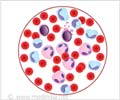In a landmark breakthrough, a company has announced that a new drug may help patients suffering from a highly resistant form of leukemia
In a landmark breakthrough, a company has announced that a new drug may help patients suffering from a highly resistant form of leukemia.
ChemGenex Pharmaceuticals Limited (ChemGenex) (ASX:CXS) announced that the latest data from its pivotal study of omacetaxine in patients with T315I-positive chronic myeloid leukemia (CML) was the subject of an oral presentation and discussion today at the 2009 American Society of Clinical Oncology (ASCO) Annual Meeting in Orlando, Florida. The open label Phase 2/3 study (CGX-635-CML-202) investigated the use of omacetaxine, administered subcutaneously in CML patients who had failed imatinib and who have the highly drug resistant T315I kinase domain mutation.Dr. Jorge Cortes, MD, Professor of Medicine and Deputy Chair in the Department of Leukemia at The University of Texas, MD Anderson Cancer Center, a lead investigator in the study, presented the data. Dr. Cortes said, "It appears that omacetaxine was well tolerated in this study and durable hematological and cytogenetic responses were observed in some CML patients with the T315I mutation." He added that "Several novel drugs have already been investigated in this difficult-to-treat population, but they have not had a reasonable risk:benefit ratio. These results suggest that omacetaxine may represent the first viable treatment option for this population of patients who currently have no established treatment options."
Data were presented from 66 patients: 40 in chronic phase, 16 in accelerated phase and 10 in blast phase. Highlights of the data were:
Chronic phase patients
- Complete hematologic response (CHR) rate of 85% with a median response duration 8.9 months
- Major cytogenetic response (MCyR) rate of 15% with a median response duration 6.1 months
Accelerated phase patients
- CHR rate of 31% with a median duration 4.1 months
- MCyR rate of 6% with a median response duration 1.8 months
Blast phase patients
- CHR rate of 20% with a median duration 3.3 months
Advertisement
Investigators reported that omacetaxine is generally well tolerated, and that the most common side effect is reversible and transient myelosuppression.
Advertisement
Dr. Collier and ChemGenex's Chief Medical Officer Dr. Adam Craig will host an investor conference call and webcast to discuss the clinical results from both ASCO and the EHA Congress on Thursday 11th of June at 10 am AEST. Details of this event will be advised in coming days.
Omacetaxine OverviewOmacetaxine mepesuccinate is a first-in-class cetaxine with demonstrated clinical activity as a single agent in a range of hematological malignancies. Omacetaxine has a novel mechanism of action, specifically binding to the ribosomal A-site cleft and inhibiting protein translation of short-lived oncoproteins that are upregulated in leukemic cells (particularly Cyclin-D1, Mcl-1 and c-Myc). As omacetaxine acts independently of tyrosine kinase inhibitors, it may have a therapeutic advantage for patients who have developed resistance to TKIs. Omacetaxine is administered subcutaneously.
Source-Eurekalert
RAS











